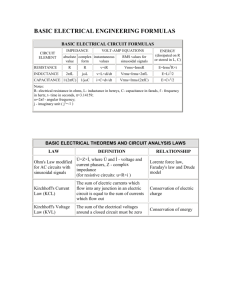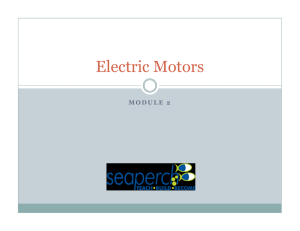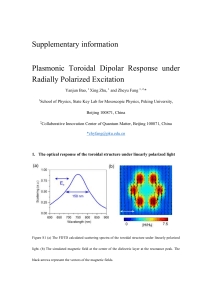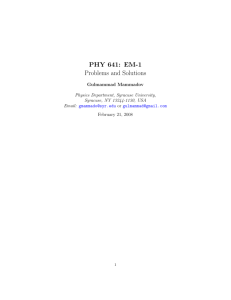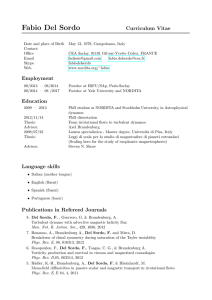is 0
advertisement
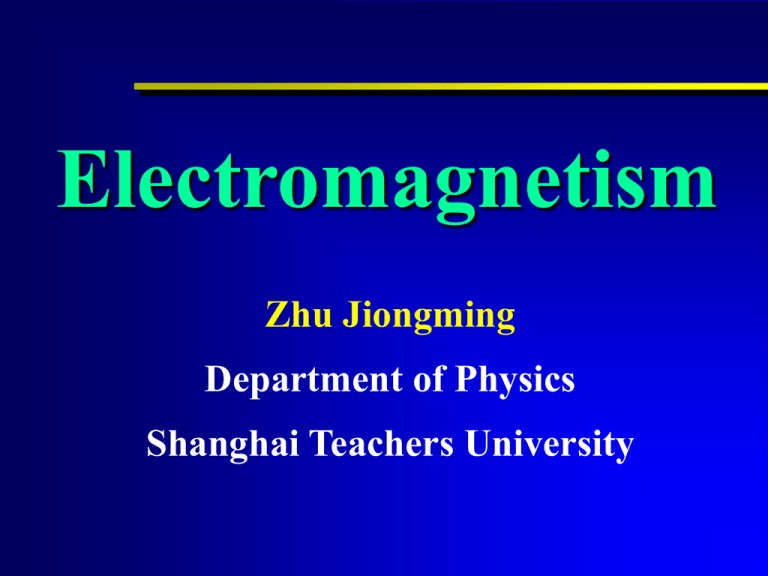
Electromagnetism Zhu Jiongming Department of Physics Shanghai Teachers University Electromagnetism Chapter 1 Chapter 2 Chapter 3 Chapter 4 Electric Field Conductors Dielectrics Direct-Current Circuits Chapter 5 Chapter 6 Chapter 7 Chapter 8 Chapter 9 Magnetic Field Electromagnetic Induction Magnetic Materials Alternating Current Electromagnetic Waves Chapter 7 Magnetic Materials §1. Basic Laws in Magnetic Materials §2. Paramagnetism and Diamagnetism §3. Ferromagnetism and Ferromagnetics §4. Magnetic Field Energy §1. Basic Laws in Magnetic Materials 1. Magnetizing and Magnetization of Materials ● Magnetizing ● Magnetization 2. Magnetization Current 3. Magnetic Field Intensity Ampere’s Law in Magnetic Materials 4. Examples 1. Magnetizing and Magnetization magnetic material magnetized loop model for electron orbits Comparison: dielectric material polarized electric dipole Magnetizing Magnetization Magnetizing of Materials loop model atomic magnetic dipole moment pm aligned (magnetized) i cancel out inside pm bound current on outline I free current(conducting) I0 B0 bound current(magnetized)I’ B’ B = B0 + B’ Magnetization Magnetization:vector sum of pm per unit volume M pmi V i compare: P pi V i Uniform:M is same at every point in material ferromagnetic magnetic paramagnetic materials non-ferromagnetic diamagnetic Experiments:in isotropic non-ferromagnetics M = gB compare: P = 0E paramagnetics :g > 0 M and B same direction diamagnetics : g < 0 M and B opposite 2. Magnetization Current(1) surface S,border L bound current I’ passing through S S Only the loop currents round L contribute to I’ L 2. Magnetization Current(1) surface S,border L bound current I’ passing through S S Only the loop currents round L contribute to I’ L 2. Magnetization Current(2) N :number of molecules per unit volume M Im : molecule’s loop current S inclined cylinder: length dl , base area S of loop dl volume: Sdl cos number of loop: NSdl cos (center of which in the cylinder) current: dI’ = ImNSdl cos Npmdl cos M dl I ' M dl L Compare:q' P dS S 2. Magnetization Current(3) dI ' j' dS dI ' i' dl dl dI’ Surface current density —— charges perpendicularly passing through unit length per unit time ( on surface ) It is proved(skip) Uniformly magnetized: j’ = 0 Interface between two materials: ’ = ( M2 - M1 ) n (n:2 1) Compare:uniform ’ = 0 ’ = ( P2 - P1 ) · n 3. Ampere’s Law in Magnetic Materials B dl I (I ( I M dl ) 0 L 0 0 B ( L 0 0 1 I ') E dS S M ) dl I 0 Definition : H B L M Definition:D 0E + P Electric displacement D dS q 0 Vacuum: M =0, B = 0H (q0 P dS ) S 0 Magnetic field intensity H dl I 0 S 0 ( 0 E P ) dS q0 L 0 1 (q0 q' ) 0 S B dl I L 0 0 Magnetic Field Intensity H H B 0 H ( M B D 0E + P M 1 0 g )B 1 B D 0 E 0 E E H (r 1) H m H 0 B 0 ( H M ) 0 (1 m ) H 0 r H H D 0 E 0 E 0 (1 ) E 0 r E E Magnetic Field Intensity H Relationship between B and H B = 0 ( H + M ) M = m H B = 0 ( H + m H ) 0 (1 m ) H 0 r H H Magnetic susceptibility : m Relative permeability : r = 1 + m Permeability : = 0 r Permeability of vacuum : 0 Example 1(p.288/[Ex.]) Toroidal solenoid,r << R r Known:I0, n, , V Find:H, B, L Sol.:inside:take a loop as shown LH dl Hin 2R nI 0 2R H in nI 0 (tangent ) R Bin H in nI 0 (tangent ) ( outside:Hout = 0 , Bout = 0 ) S = BinS = nI0S ,S= NS= n2R·nI0S = n2V I0 L = S/I0 = n2V (vacuum: L0 = 0n2V ) = rL0 Example 2(p.315/ 7 - 1 - 1)(1) Uniformly magnetized sphere R Known:R, M(along z axis) Find: ’ (on surface),pm Sol.: ' ( M M ) nˆ 2 z 1 M rˆ M sin ˆ (direction:right hand rule) dpm dI ' Szˆ ' dl Sẑ 'Rd ( R sin ) 2 ẑ MR sin dẑ 3 M o 3 Material 2,vacuum 1 n=r (21) M2 = M, M1 = 0 Example 2(p.315/ 7 - 1 - 1)(2) dpm MR 3 sin 3 dzˆ pm dpm MR 3 sin 3 d 0 MR (1 cos 2 )dcos 0 1 3 3 MR ( cos cos ) 3 0 4 MR 3 MV 3 ( direction:along z ) Consider:a vacuum sphere in an infinite magnetic material (find ’ on surface etc.) 3 Exercises p.315 / 7 - 1 - 2, 3, 4 §2. Paramagnetism and Diamagnetism 1. Paramagnetism 2. Diamagnetism 1. Paramagnetism Molecules, atoms electrons orbital/spin magnetic dipole moment not cancel:permanent magnetic moment pm cancel out: pm is 0 ( of a molecule ) pm paramagnetism external field B = 0 , thermal motion pm orient randomly,cancel out M = 0 B 0,pm tend to line up with B M 0 paramagnetic material: pm 0 include:aluminium, natrium, oxygen etc. 2. Diamagnetism(1) Exhibited by all materials, very weak, opposite to B material with pm 0,exhibit paramagnetism material with pm = 0,exhibit diamagnetism electron moving in a circular path,B introduced,r no change, increased pm changed, opposite to B diamagnetism 0 e e 0 v I T0 2 -e 2 er 2 pm0 pm 0 Ir 0 2 2. Diamagnetism(2) Assume B and 0 in the same direction B L EI dl S t dS B0 2 EI 2r r t r B er B EI F eEI 2 t 2 t erB eB v Ft mv 2m 2m Lorentz force: FL = e ( v0 + v ) B 2 mv Centripetal force:F 0 0 r m(v0 v) 2 F r B F -e EI 2. Diamagnetism(3) m F F0 (2v0 v v 2 ) r 2m (v0 v)v r 2m erB (v0 v) r 2m (v0 v)eB FL eB er 2 pm 0 0 2m 2 r unchanged, > 0 B -e pm 2 er pm 0 2 pm opposite to B diamagnetism, very weak §3. Ferromagnetism 1. Magnetizing Properties of Ferromagnetic Material 2. Classification and Application 3. Magnetic Domains B non-ferromagnetism: M = gB = mH B = H ferromagnetism:? —— experiment 0 H Experiment Experiment: A test B 1 2 R Adjust R to control I Electromagnetic obtain H = nI induction SKIP EXPERIMENT 1. Magnetizing Properties(1) open switch,H = 0,B = 0,O B S R maximum,switch to 1,A R C R,H,B ,AC A continue,B changing slow down o H beyond S,H,B almost not change (saturation magnetic intensity HS) H to 0,B- H curve not retraced H = 0,B 0(residual field)magnetic hysteresis switch to 2,I reversed,H:0 -HS H = -HD ,B = 0,HD rectification force H:-HS HS ,closed,hysteresis loop 1. Magnetizing Properties(2) Saturation magnetic intensity HS Residual field BR Magnetic hysteresis Rectification force HD D Hysteresis loop (Symmetry about O) Small hysteresis loop H corresponding to many B S’ Magnetization curve H and B : 1 to 1 B S R o D’ R’ H 1. Magnetizing Properties(3) Magnetization curve B, H and B :1 to 1 Permeability of a ferromagnetic material: B H O not a constant very large r ~ 10 4 B H 2. Classification and Application Three characteristics: high :strong field by weak current, motors, transformers B Soft Non-linearity:non-linear elements Magnetic hysteresis: permanent magnets o Classification: Hard Soft magnetism Hard magnetism H 3. Magnetic Domains (Quantum theory) Magnetic domains:magnetized regions Effect of external magnetic field: growth in size of the domains oriented along B shift of the orientation of dipoles in a domain Magnetizing:H,M,BT> T paramagnetism C B = 0 (H + M ) T < TC ferromagnetism saturation: M stop increasing TC :critical temperature Not reversible:as H removed Curie Point Temperature:thermal motion H = 0, M = 0 Exercises p.316 / 7 - 3 - 1 §4. Magnetic Field Energy Energy density wm at every point in the magnetic field Consider a solenoid inside: H = nI,B = nI (uniform field) outside:H = 0,B = 0 Self-inductance:L NBS nl nI S n 2V I I I 1 2 1 2 2 1 Magnetic energy:Wm LI n VI HBV 2 2 2 Wm 1 1 HB H B Energy density: wm V 2 2 1 Non-uniform: wm( x, y, z ) Wm VH BdV 2 Example A long coaxial cable made of cylinders of radius r1< r2 and material of permeability carries a current I . Find magnetic energy and self-inductance of a length l. Sol.:H = I / 2r ( r1< r <r2 ), H=0 ( r < r1, r > r2 ) 2 1 I wm H 2 2 2 2 8 r Wm wmdV V I 2l r2 ln 4 r1 r2 r1 I 2l r dr I 2 l 2rdr 2 2 4 r r 8 r 2Wm l r2 ln L 2 2 r1 I 2 1 Exercises p.316 / 7 - 6 - 1, 2, 3
